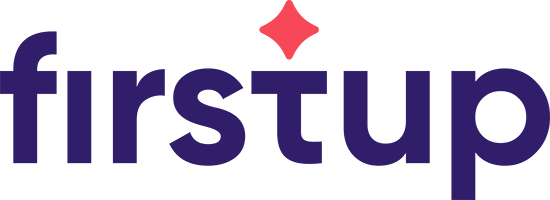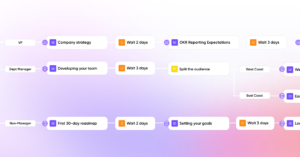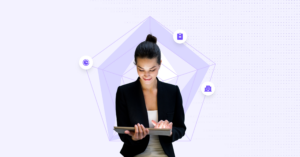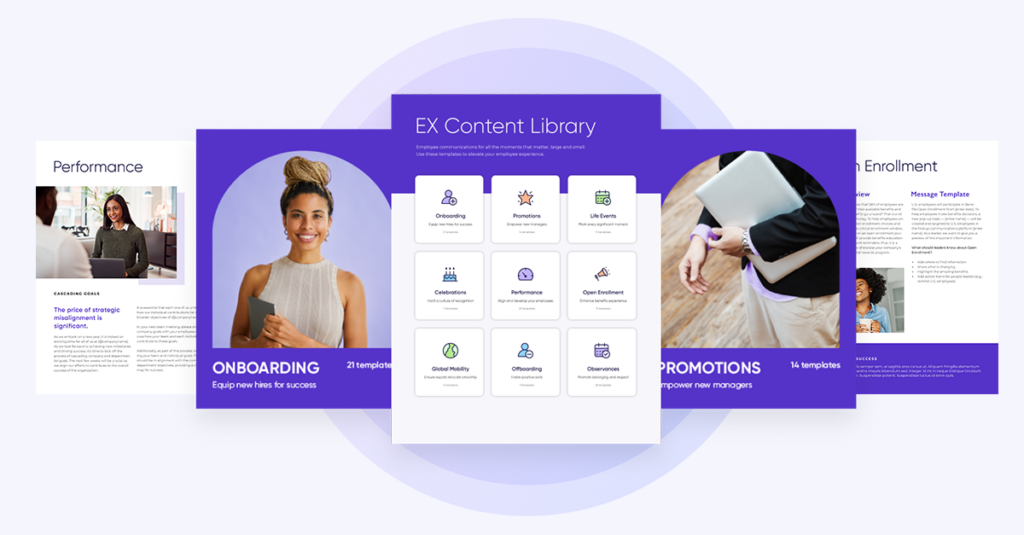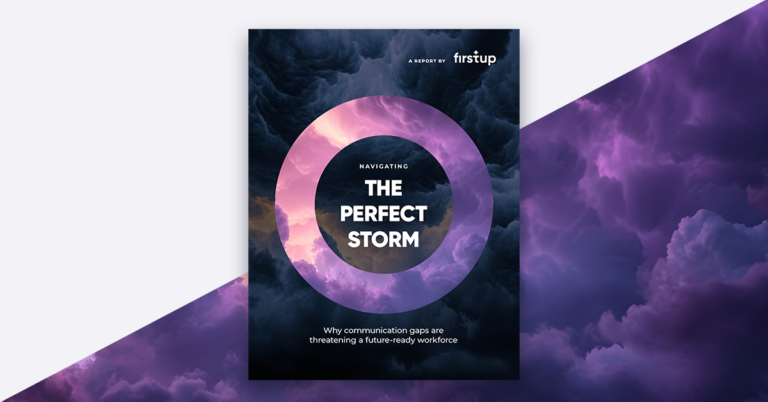Today’s workplace is more dispersed than ever, with about 100 million workers worldwide participating in hybrid work. On top of that, employees expect more than just generic, top-down communication; they want personalized, relevant interactions tailored to their specific role, designed to support their development, and primed to help them feel connected to something bigger—but doing all that at scale is a challenge.
How can you deliver timely, relevant communication to thousands of employees with different roles, locations, and needs?
This blog post explores the role of artificial intelligence (AI)-powered orchestration in the employee experience and how AI can transform workforce engagement and create better employee experiences.
The role of AI-powered orchestration in the employee experience
The employee experience encompasses all interactions in an employee’s journey—from onboarding to daily operations to eventual exit. Each of these moments impacts how employees feel about their roles, their teams, and your organization as a whole.
For large enterprises, supporting strong employee experiences at scale is a challenge. But AI is changing the game.
AI-powered orchestration enables organizations to create more personalized, engaging work environments. It goes beyond simply automating message delivery to ensure that the right employee gets the right message at the right time, in the right channel, with the right context. This orchestration transforms communication from generic broadcasting into personalized, real-time interactions that build trust, drive engagement, and improve performance.

AI-powered tools to transform workforce engagement
Bringing AI-powered orchestration into the employee experience isn’t just about saving time. These tools improve connection, reduce friction, and deliver the kind of timely, relevant communication that improves engagement, overall job satisfaction, and performance.
These are some of the ways AI technology reshapes workforce engagement:
Virtual assistants and chatbots
AI-powered virtual assistants and chatbots deliver instant, 24/7 access to information, helping employees find what they need, when they need it.
This is particularly helpful for HR teams who are often bogged down by requests for benefits enrollment, PTO balances, and onboarding FAQs. One report from IBM reveals that AI chatbots can improve HR operations for all teams, helping HR professionals take a proactive approach to in-office inquiries for greater employee satisfaction.
Machine learning (ML) algorithms
ML takes your organization’s data and turns it into meaningful insight you can use to proactively support employees. For example, by analyzing patterns in behavior, engagement levels, and performance data, ML algorithms can uncover trends to identify areas for improvement and then create personalized recommendations for next steps—like flagging when an employee may benefit from manager feedback.
The technology also helps teams make smarter decisions. Research from the University of Maryland Global Campus explains that “machine learning algorithms can process historical project data to predict outcomes, enabling project managers to make data-driven decisions that optimize project performance.”
CommunicationAI
Firstup’s CommunicationAI takes intelligent orchestration to the next level, combining real-time engagement signals with powerful ML to deliver highly personalized, automated communications at scale.
Specifically, CommunicationAI can enable:
- Dynamic audience segmentation based on employee behavior, role, and location
- Intelligent timing that maximizes engagement by choosing the best moment and channel
- Predictive content suggestions that align with employee needs and journey stages
- Continuous feedback loops to refine messaging and improve outcomes
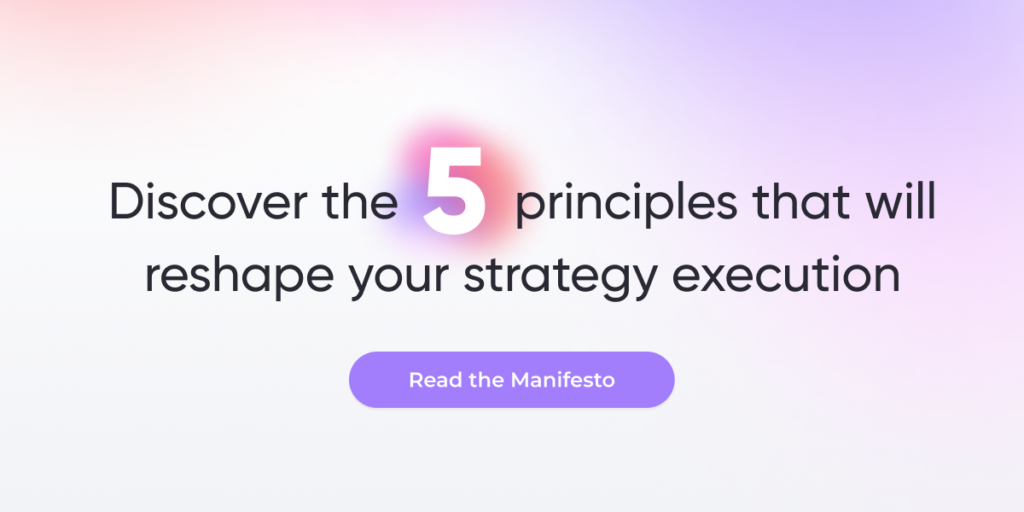
What’s the difference between simple automation and AI-powered orchestration?
Automation and AI are often used together or even interchangeably. While both technologies help simplify process and reduce manual work, they are different—especially when it comes to the employee experience;
Automation is simply rule-based. It follows basic if-this-then-that logic. For example, when your organization hires a new employee, simple automation can kick off the onboarding process by sending a welcome email. Automation can eliminate mundane tasks, but they’re limited. It can’t learn from its interactions; it can’t adapt in real time; and it can’t personalize content based on context or other factors.
AI-powered orchestration is truly intelligent. It combines simple automation with machine learning algorithms and real-time engagement data to deliver personalized, responsive communication at scale.
Rather than just executing fixed, rule-based workflows, AI-powered orchestration can understand where employees are in the employee journey, analyze how they interact with content in real time—and then adjust messages accordingly to choose the right message, timing, and channel for each employee.
10 ways artificial intelligence can improve employee engagement
With increasingly complex work environments where organizations must accommodate in-office, hybrid, remote, and deskless employees, it’s a challenge to support and maintain employee engagement at scale. AI helps make things easier.
By leveraging real-time data, behavioral insights, and predictive analytics, AI-powered orchestration can help organizations anticipate needs, personalize communication, and create more meaningful experiences for every employee.
1. Provide valuable insights into employee behavior and performance
AI-powered tools can provide actionable insights into behavior and performance data, enabling teams to optimize workplace planning with more strategic, data-driven decisions.
Specifically, generative AI and data analytics can give business leaders real-time dashboards with employee performance metrics to analyze workforce trends and:
- Spot disengagement before it turns into attrition
- Pinpoint skills gaps to inform training and development strategies
- Identify high-performing individuals for growth opportunities
- Align workplace planning with long-term organizational goals
2. Segment audiences and tailor communication styles
Not every employee wants to receive the same message in the same format. Actually, 51% of deskless workers would prefer to receive updates via mobile-based channels, such as text messages or push notifications—however, 69% of organizations still rely on email for their primary channel of communication.
AI helps make sure everyone is accommodated. By analyzing engagement patterns, AI can segment audiences based on role, location, and behavior to recommend the best communication style for different groups, like in-depth updates for remote workers and mobile notifications for deskless workers.
With this niche segmentation and personalization, AI ensures messages are more relevant, less likely to be ignored, and more likely to drive engagement and action.
3. Optimize timing for maximum engagement
Right message, right channel, and right timing all contribute to better workforce engagement. Unfortunately, 39% of workers say messages often arrive at inconvenient times.
AI can help by analyzing past engagement behaviors and engagement patterns to predict the best time to send messages to employees to maximize visibility and effectiveness. For example, AI may suggest:
- Morning updates for office staff
- Mid-shift push notifications for frontline workers
- End-of-day summaries for global teams
By sending messages when employees are most likely to engage, organizations can increase the changes of meaningful interactions and stronger engagement.
4. Enable multichannel delivery for broader reach
Modern workforces are no longer confined to the office desk. In fact, 92% of organizations include a mix of desk-based and deskless employees, each with their own communication preferences.
Supporting such dispersed workforces is proving challenging: 22% of workers say there are too many places to look for company information, and 25% say they don’t know where to find critical updates.
AI-powered orchestration ensures no one is left behind. It enables multi-channel communication, strategically delivering messages in the format and channel each employee prefers, whether that’s email, mobile, SMS, or even digital signage. This flexible approach makes communication more accessible, inclusive, and effective—especially frontline workers who may not have access to laptops.

5. Automate employee feedback collection and sentiment analysis
Communication is a two-way street. That means not talking at employees, but actively listening—collecting feedback to understand how employees feel, what they need, and how you can better support them. AI makes this process faster, smarter, and more scalable.
An AI-powered communication platform can automate employee feedback loops by scanning text for sentiment and flagging trends for HR so teams can step in and take action before they become bigger employee issues. Instead of responding to disengagement retroactively, organizations can get a real-time pulse on how employees are doing across locations and roles.
With this on-demand feedback, leadership can:
- Spot patterns in morale or job satisfaction
- Identify where engagement is slipping
- Make proactive, data-driven adjustments to better engage employees
6. Provide dynamic content personalization
Organizations must connect a diverse workforce with varying roles, locations, and engagement preferences. Accommodating the needs and preferences of every employee simply isn’t possible with generic, company-wide communication blasts. That’s why 53% of workers say communications are only somewhat relevant to their role; worse, 21% say communications are completely irrelevant.
AI tools help teams personalize communication for every employee, whether they’re in office, remote, or completely deskless. By pulling employee attributes, such as job function, location, behavior, and even language preference, AI can tailor the tone, format, and content of messages to match employees’ specific needs. This kind of dynamic content personalization ensures employees receive relevant, useful information, driving greater satisfaction, productivity, and engagement.
7. Proactively address employee needs with predictive analytics
Instead of reacting to turnover or low morale after the fact, organizations can use AI to deploy targeted campaigns to proactively prevent dissatisfaction and disengagement.
By analyzing engagement patterns, sentiment shifts, and behavior signals, organizations can pinpoint areas of low interaction, signaling where certain individuals may need extra support. This way, leadership can step in and take action to provide further guidance and mitigate risks of disengagement. An AI-driven communication platform can even suggest the right message or action to take, whether that’s a manager check-in, an upskilling opportunity, etc.
The right message resonates: 33% of workers say effective communication improves engagement, and 27% say it boosts motivation.
8. Analyze engagement data to enhance retention
It’s much easier to retain top talent when you understand what drives them—and what might cause them to leave. AI tools help HR teams sift through engagement data to identify at-risk employees and pinpoint the “why” behind their disengagement.
For example, together, generative AI and predictive analytics can quickly scan feedback from exit interviews, surveys, and manager check-ins to surface recurring employee issues, patterns, or other pain points. With this information, HR teams proactively take action and deploy personalized outreach strategies to re-engage low-morale employees.
When engagement becomes measurable, it’s easier to take action: 29% of workers say strong communication increases their likelihood of participating in company initiatives.
9. Ensure data privacy and compliance
To deploy personalized communication strategies that improve employee engagement, organizations must collect and analyze employee data, introducing potential concerns about data security, privacy, and compliance. This is particularly challenging for modern workforces made up of in-office, frontline, and remote workers; 61% of IT security leaders say a remote (worker) has caused at least one data breach in the last year.
AI can play an important role in data security to help organizations safeguard sensitive employee data. For example, AI-driven security tools can monitor data access and usage around the clock to flag any irregularities that might suggest unauthorized access. Meanwhile, AI-generated audit trails can help HR teams comply with privacy protocols, creating a detailed, easily accessible record of all data interactions across the organization.
When employees know their personal data is secure and used responsibly, it builds trust—an essential component of positive employee experience.
10. Automate essential HR tasks and communication
It’s not easy to say which department owns internal communications, but HR certainly plays a big part in it. AI can help ease HR teams’ busy workloads by automating key campaigns and administrative tasks, like:
- Onboarding
- Open enrollment
- Compliance training
- Distributing follow-ups and reminders
Importantly, an intelligent AI communication platform will allow HR teams to personalize automated communications based on employee attributes, like location, job title, language preference, etc.
It’s a win-win: Automated, tailored messages lighten HR teams’ to-do lists while keeping employees engaged for better retention and boosted satisfaction.
Belonging drives engagement
How AI tools can create a better employee experience
The employee experience starts on an employee’s day one at your organization and extends until their eventual exit interview. Every step of the way, an effective employee experience strategy should drive engagement, increase productivity, and improve retention—but that’s a mounting challenge for large-scale, dispersed enterprises.
AI helps large enterprises improve the employee experience by automating the employee journey, streamlining daily workflows, and delivering personalized feedback to every employee.
Automate and personalize the entire employee journey
An AI-powered communication platform can automate the entire employee journey—from onboarding to daily operations to onboarding. For instance, during onboarding AI can:
- Automatically assign training modules based on role
- Connect new hires with mentors
- Deliver helpful, role-specific content—at the right time, in the right channel
Personalized, AI-supported onboarding journeys support employees to feel engaged and connected from their first day at your organization.
Take over repetitive tasks to improve daily workflows
Repetitive tasks degrade the employee experience by taking up time, adding friction, and causing unnecessary frustration. In fact, Asana reports that 62% of the workday is lost to mundane administrative tasks.
AI can step in to automate these tasks, de-stressing employees and giving them more time back in their day to focus on more energizing, creative tasks that need a human touch to drive bigger business impact.
For instance, AI can dramatically improve HR teams’ daily routines with workflow automation that:
- Automate routine employee outreach
- Manages compliance reminders and deadlines
- Processes payroll and benefits
Deliver personalized feedback and coaching
AI can support a better employee experience by empowering employee development with continuous, personalized feedback.
Individual feedback is difficult to scale manually. But by analyzing performance data and behavior trends, AI can support leadership by connecting employees directly with relevant coaching content, identifying moments for manager check-ins, or delivering real-time recognition for achievements.
This kind of timely, personalized guidance has a significant impact: Effective communication gives 60% of employees a confidence boost, while 61% say better communication would directly improve their performance and increase productivity.

5 steps to implement AI and automation for a better employee experience
Deploying AI in a way that supports employees, drives engagement, and creates positive employee experiences requires thoughtful planning, strategic alignment, and clear communication. Here’s how to get started:
- Identify where AI can add the most value: Consider how you’ll integrate the technology with your employees and business goals to improve engagement and create a more positive employee experience.
- Develop a clear strategy: Define specific goals and objectives. Without a set strategy, AI implementation can backfire if it doesn’t align with your employees’ needs or business priorities.
- Invest in tools that deliver intelligent engagement at scale: Firstup’s CommunicationAI combines natural language prompts, sentiment analysis, predictive analytics, and an AI-powered digital assistant to orchestrate personalized, timely communication throughout the employee journey.
- Provide training to support teams: For smoother adoption, equip teams with the training and resources they need to feel confident with AI. Specifically, help teams understand what the new technology is, why it’s being implemented, and how it will support them.
- Track results to ensure your strategy is working: Don’t just track clicks and opens—measure impact. For example, use analytics to monitor message reach, engagement, and behavioral change.
Conclusion: Transform workforce engagement with an AI-powered communication platform
AI is often celebrated for its ability to cut repetitive tasks, accelerate response times, and streamline workflows. But used right, AI tools can also create more positive employee experiences that foster engagement and create happy, productive employees.
By leveraging AI for dynamic segmentation, journey automation, and personalized content delivery, organizations can meet employees where they are with timely, relevant communication that resonates. The result? Higher engagement, more connected teams, and a workforce that’s empowered to do their best work.
Download PDF
